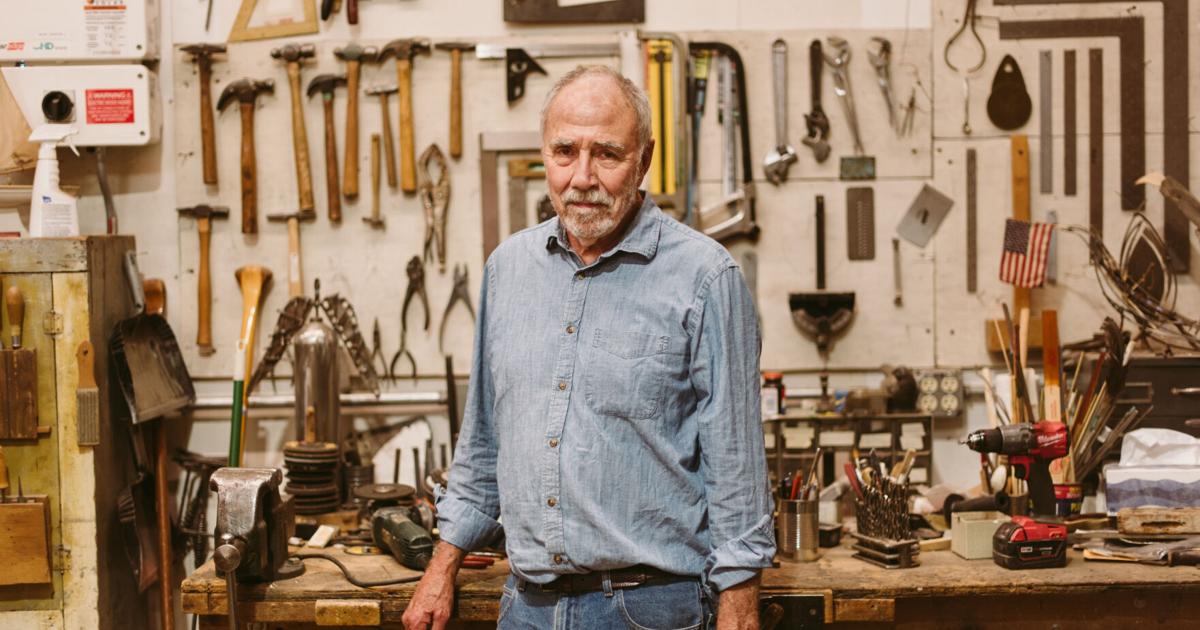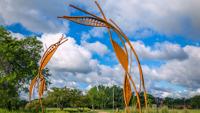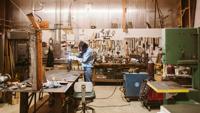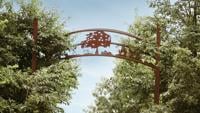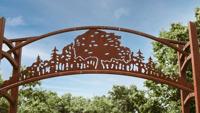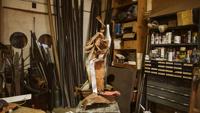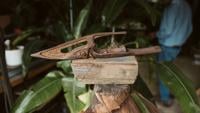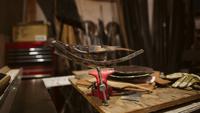Michael A. Burns’ works have been shown in museums, art shows, and even the White House. In Madison, his sculptures — some with a maker’s mark, some without — are an integral part of the city’s parks and public spaces, including the UW Arboretum, Troy Community Gardens, Olbrich Botanical Gardens and Tenney Park.
“Doing public art means bringing everyone in on the ownership, and that is a very important aspect of that work for me,” says Burns.
Take “Updraft,” which consists of two 20-foot-tall arches framing the bike path in Brittingham Park. The concept came from Burns’ childhood memory of lying in the back of his grandfather’s pickup truck and looking up at the canopy formed by the branches of elm trees lining the street.
Photo by Steve Agard
“It was like going through a cathedral,” says Burns. While approaching “Updraft” head-on, bikers and pedestrians see an arch. But the two halves of the sculpture are set a few feet apart from each other on either side of the path, creating a sense of depth as people pass through.
That installation — like all public artworks — was a marriage of creative vision, public input, multiple funding sources and safety requirements. While Burns continues to take on public art projects (like a recent commission for a 350-unit apartment building in Fitchburg), he’s also starting to turn his attention toward more personal work.
Recently, he’s found inspiration and purpose in transforming scrap metal and found objects.
“I’ve repurposed things that had outlived their original function and [given them] new life,” he says.
From the Artist: Michael A. BurnsOrigin Story
I [thought] science would be my path, but I hit the wall of calculus and that was that. … When I reenrolled at the University of Wisconsin–Madison, I eventually found ceramics, wood and metal with three pivotal faculty members — Don Reitz, Skip Johnson and Fred Fenster.
Lasting Skill Set
The UW Arboretum and Brittingham Park [projects] — these required partners, industrial processes and skills that I hadn’t realized I had. And the materials and techniques should enable them to be around for a good long while.
Safety First
All of the public work I do, I’m really conscious that it’s going to be accessible to everyone who wants to interact with it. That means considering sharp and dangerous parts. You can’t keep someone from climbing something, but you can keep the sharp edges away so they don’t cut themselves.
A New Chapter
I’m scaling back the public work — possibly. I’m doing more stuff for me. “Updraft” was my child, from beginning to end, but it had to satisfy certain requirements for safety and stability. My recent projects are different, where I’m totally thinking about design and not those other factors.
Close
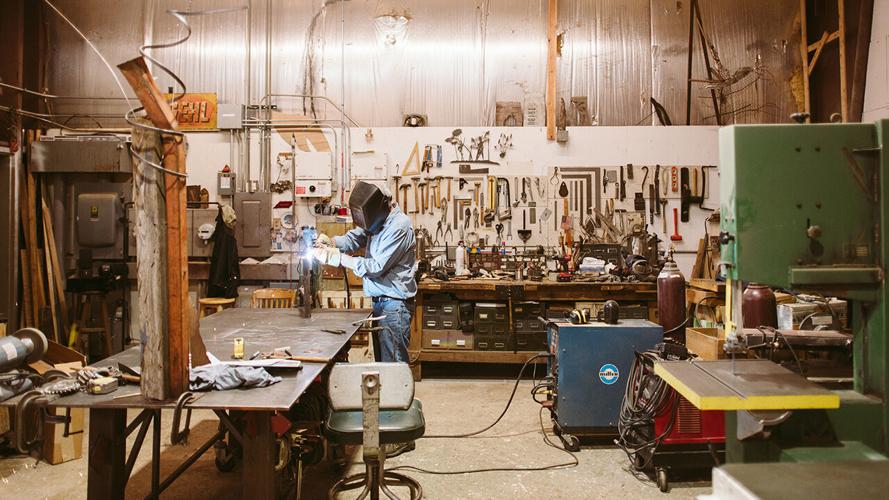
In addition to spending time in his studio, Burns enjoys gardening, sailing, hiking, skiing and mushroom hunting. “But I think you can [make] progress without hitting it head-on,” says Burns. “You let it sit.”

Perhaps Burns’ most recognizable local works are the three fabricated steel arches in the UW Arboretum. All three are placed at transition points, like the entrance to Longenecker Horticultural Gardens from the visitor center parking lot. “There was nothing there before, just a pathway, and they wanted to create an environment where you stepped into a space,” says Burns.

Each UW Arboretum arch pays tribute to native flora and fauna. The central outline of a white oak tree is an image Burns developed with Molly Fifield-Murray, who began the Wingra Oak Savanna restoration project in 1992. “Talking to the staff, they wanted to emphasize important species and also commemorate the different work that’s gone on in the Arboretum,” says Burns.

“If I’m going to summon up stuff using materials and fuel, putting wear and tear on my body and on my equipment, then there needs to be a reason,” says Burns. Recently, he’s been working with scrap metal. He has created art including works inspired by crows and a 3-foot metal column inspired by “The Little Mermaid,” a bronze statue in Copenhagen, Denmark (above).



In addition to spending time in his studio, Burns enjoys gardening, sailing, hiking, skiing and mushroom hunting. “But I think you can [make] progress without hitting it head-on,” says Burns. “You let it sit.”

Perhaps Burns’ most recognizable local works are the three fabricated steel arches in the UW Arboretum. All three are placed at transition points, like the entrance to Longenecker Horticultural Gardens from the visitor center parking lot. “There was nothing there before, just a pathway, and they wanted to create an environment where you stepped into a space,” says Burns.

Each UW Arboretum arch pays tribute to native flora and fauna. The central outline of a white oak tree is an image Burns developed with Molly Fifield-Murray, who began the Wingra Oak Savanna restoration project in 1992. “Talking to the staff, they wanted to emphasize important species and also commemorate the different work that’s gone on in the Arboretum,” says Burns.

“If I’m going to summon up stuff using materials and fuel, putting wear and tear on my body and on my equipment, then there needs to be a reason,” says Burns. Recently, he’s been working with scrap metal. He has created art including works inspired by crows and a 3-foot metal column inspired by “The Little Mermaid,” a bronze statue in Copenhagen, Denmark (above).


Michael A. Burns | mbmetalworks.com
Anna Kottakis is digital editor at Madison Magazine.
COPYRIGHT 2025 BY MADISON MAGAZINE. ALL RIGHTS RESERVED. THIS MATERIAL MAY NOT BE PUBLISHED, BROADCAST, REWRITTEN OR REDISTRIBUTED.
